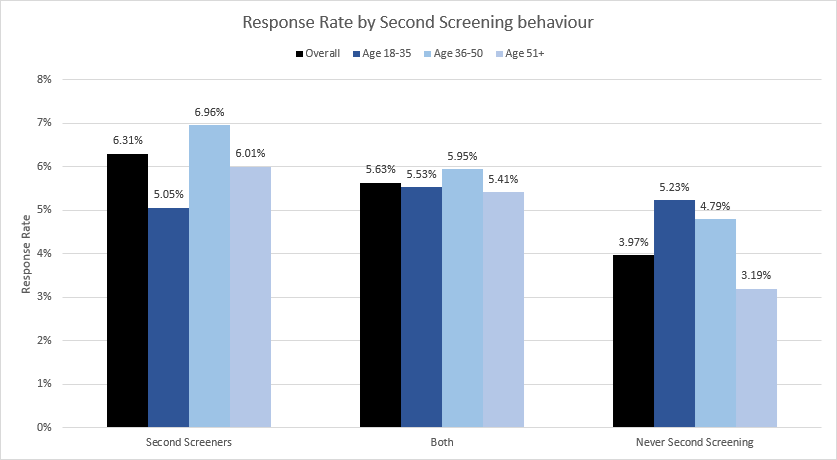In the study, ViewersLogic showed a panel of participants divided into “consistent second-screeners”, “non-second-screeners” and “occasional second-screeners” TV ads from seven brands to gauge the impact of second-screening on response rates and how this correlated with gaze and attention.
Results revealed second-screening impressions had a 59% higher response rate compared with non-second-screening impressions.
This was established through a passive monitoring app on participants’ phones that could determine whether an app was active at the same time as exposure to a TV ad. Response rate was defined by the study as the percentage of exposure within each group that led to a website visit in seven days.

ViewersLogic suggested a potential reason for the higher response rate among second-screeners could be “a mental defence” being in place when an ad is observed with full attention — something that comes down when a person is doing something else while watching an ad.
In addition, according to ViewersLogic, these findings suggested “gaze does not necessarily correlate to attention and is probably more complex”, given that users who did not “gaze” at the TV ads in question had a better conversion rate.
The research added: “If gaze is being used as a proxy for sales, measurement companies need to be able to provide concrete data to prove those sales are a direct result of gaze.”
Nuances to second-screening responses
An exception to the response rate trend isolated in the study was the 18-35 age group, who showed “consistently independent” response rates whether they were second-screening or not. This group recorded a 3.5% higher response rate in favour of non-second-screening.
This implied that the beneficial nature of second-screening on responsiveness might not apply to younger audiences, potentially because the group grew up watching TV and other devices at the same time.
Brands involved in the study were: Airbnb, B&Q, Bet265, Booking.com, Compare the Market, Direct Line and Etsy.
Attention is not a silver bullet
Rich Kirk, joint chief strategy officer at EssenceMediacom, told The Media Leader that these findings echoed recent research on media channels’ signalling strength.
He explained: “Attention is really useful, but it’s absolutely not a silver bullet. If you were to adopt attention-adjusted reach curves — which can be a useful thing to do, but if it’s the only thing you were going to do, then you’re going to leave a lot of potential advantage, knowledge and insight on the table.
“Eye-tracking essentially works brilliantly as a step on from viewability and dwell time and things like that. It’s a more sophisticated way of thinking about that problem. But it’s not the be-all and end-all for how much impact is this advert having on a consumer, because there’s much, much more to unravelling impact than just gaze.”
Kirk added that there was “a big gap between reach and impact” and while looking at what people gaze at or turn their eyeballs towards is useful in understanding the difference, it was “absolutely not the whole picture”, since it does not explain everything.
Kirk said second-screening was something that “everyone accepts” as a reality of current media planning and that, for media not on a mobile, the likelihood would be some people will be on their phone when the impact takes place.
“It’s great to understand that, actually, even though they’re not looking at the impact, it doesn’t necessarily mean that that impact is wasted. It could actually be quite effective, but it’s very, very hard to plan to filter out second-screening. You just have to accept it as a bit of a fact of life,” he added.
“I’ve never really encountered clients who say: ‘I hate second-screening because if someone’s second-screening it absolutely means my impact is wasted.’ It’s always great to hear that there’s now some hard evidence that it could potentially be beneficial and it’s certainly not a blocker to the ad being observed and understood.”
Source: the-media-leader.com



